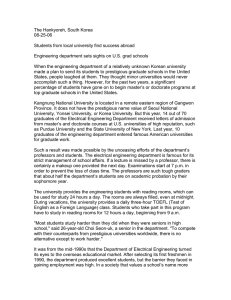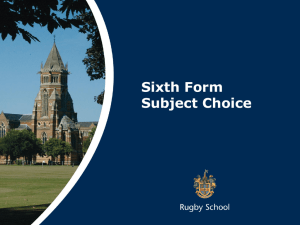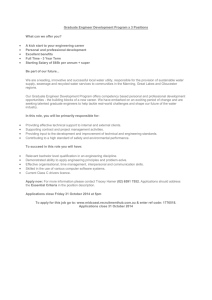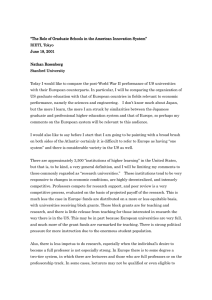1 INNOVATIONS IN PUBLIC GOVERNANCE The case for the
advertisement
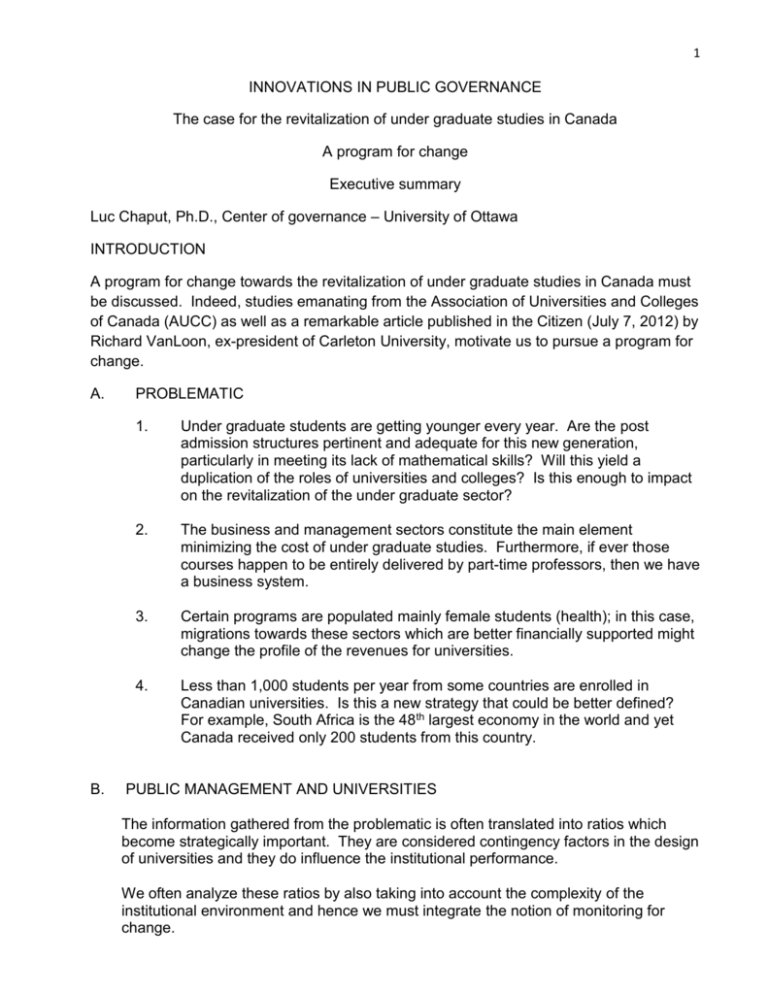
1 INNOVATIONS IN PUBLIC GOVERNANCE The case for the revitalization of under graduate studies in Canada A program for change Executive summary Luc Chaput, Ph.D., Center of governance – University of Ottawa INTRODUCTION A program for change towards the revitalization of under graduate studies in Canada must be discussed. Indeed, studies emanating from the Association of Universities and Colleges of Canada (AUCC) as well as a remarkable article published in the Citizen (July 7, 2012) by Richard VanLoon, ex-president of Carleton University, motivate us to pursue a program for change. A. B. PROBLEMATIC 1. Under graduate students are getting younger every year. Are the post admission structures pertinent and adequate for this new generation, particularly in meeting its lack of mathematical skills? Will this yield a duplication of the roles of universities and colleges? Is this enough to impact on the revitalization of the under graduate sector? 2. The business and management sectors constitute the main element minimizing the cost of under graduate studies. Furthermore, if ever those courses happen to be entirely delivered by part-time professors, then we have a business system. 3. Certain programs are populated mainly female students (health); in this case, migrations towards these sectors which are better financially supported might change the profile of the revenues for universities. 4. Less than 1,000 students per year from some countries are enrolled in Canadian universities. Is this a new strategy that could be better defined? For example, South Africa is the 48th largest economy in the world and yet Canada received only 200 students from this country. PUBLIC MANAGEMENT AND UNIVERSITIES The information gathered from the problematic is often translated into ratios which become strategically important. They are considered contingency factors in the design of universities and they do influence the institutional performance. We often analyze these ratios by also taking into account the complexity of the institutional environment and hence we must integrate the notion of monitoring for change. 2 Within the next 20 years, the segment of the population 65 years and over will double in percentage while the segment 15-64 will grow by only 8%. Universities must increase accessibility by creating new markets for highly skilled human resources; they must enhance the quality of delivery and create better learning conditions. Many theories contribute to public management theory. For example, the neoclassical school in economics, agency theory, property rights theory, and public choice theory are parts of public management. In summing up, public management is the sum of dimensions originating from all these schools of thought above. It becomes a set of concepts facilitating the monitoring of public administration while improving the performance. It is a profound quest for change, a desire for modernization. C. A PROGRAM FOR CHANGE TOWARS REVITALIZATIONOF UNDER GRADUATE STUDIES IN CANADA. The list of changes in the AUCC reports is analogous to the list of contingency factors and design parameters that we encounter in management theory. The changes which will be proposed will be homologated to these parameters and factors. PARAMETERS/FACTORS 1. Hiring of professors (human resources) DECISIONS CONCERNING THESE NANT LES PARAMETERS (P) AND FACTORS (F) P Work planning : Horizontal Vertical 2. Rewards system (human resources) High intensity Medium intensity P Formalization of behaviour : High 3. Teaching/research (strategy) P Planning and control : High intensity 4. Workload (human resources) P Specialization of work High 5. Union (structure) P Linking mechanisms: Multiple at all levels 6. Institutional barriers to innovation (management) 7. Organizational size (strategy) P Decentralization F Technology to fit with human resources F Size : Must be reduced 3 8. Unit size (structure) P Unit size : Reduced 9. Interaction/students professors (structure) P 10. Constraints experienced by students (environment) F Unit size Environment : Financial support 11. Students skills/qualifications (environment) F Environment : Post admission structures 12. Part-time professors (human resources) F Strategic human resources The major steps for changes : Integration of the four parameters not clearly identified: training, indoctrination, organic or bureaucratic structure, grouping of units. Decisions must be made concerning the level of these parameters and factors. The desired fit between the parameters P and factors F and the fit between the two systems P and F lead to innovation. Precisely, the activities for change become those that are required for the different fits. Systems theory will provide a fast track solution by analyzing the different 5 sub-systems which are human resources, strategy, structure, technology, management, all coupled with the environment. In conclusion, with established fits between the 5 sub-systems, we obtain: Management must strive to obtain an organic institution by creating flexible and adaptive practices. Once the professor has been hired, he is now able to invest himself namely because it is part of his contract. His socialization will become easier because of the now defined training and reward system. Also, there will be a policy in terms of technology coupled to human resources while considering unit size, decentralization and linking mechanisms. REFERENCES: * The revitalization of undergraduate education in Canada, AUCC, 2011 * Trends in Higher Education, AUCC, Volume 1, 2011
